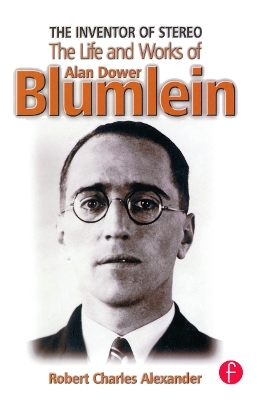
The Inventor of Stereo
The Life and Works of Alan Dower Blumlein
Seiten
2000
Focal Press (Verlag)
978-0-240-51628-8 (ISBN)
Focal Press (Verlag)
978-0-240-51628-8 (ISBN)
Presents a study of the life and works of Alan Dower Blumlein, one of Britain's important inventors. During the WWII, Alan Blumlein was engaged in the work of radar development which eventually became the blind bombing radar. This book describes his patents and the process behind them, and presents the developments in audio, electronics and radar.
This book is the definitive study of the life and works of one of Britain's most important inventors who, due to a cruel set of circumstances, has all but been overlooked by history.
Alan Dower Blumlein led an extraordinary life in which his inventive output rate easily surpassed that of Edison, but whose early death during the darkest days of World War Two led to a shroud of secrecy which has covered his life and achievements ever since.
His 1931 Patent for a Binaural Recording system was so revolutionary that most of his contemporaries regarded it at as more than 20 years ahead of its time. Even years after his death, the full magnitude of its detail had not been fully utilized. Among his 128 Patents are the principle electronic circuits critical to the development of the world's first electronic television system. During his short working life, Blumlein produced patent after patent breaking entirely new ground in electronic and audio engineering.
During the Second World War, Alan Blumlein was deeply engaged in the very secret work of radar development and contributed enormously to the system eventually to become 'H2S'- blind bombing radar. Tragically, during an experimental H2S flight in June 1942, the Halifax bomber in which Blumlein and several colleagues were flying, crashed and all aboard were killed. He was just days short of his 39th birthday.
For many years there have been rumours about a biography of Alan Blumlein, yet none has been forthcoming. This is the world's first study of a man whose achievements should rank among those of the greatest Britain has produced. This book provides detailed knowledge of every one of his patents and the process behind them, while giving an in depth study of the life and times of this quite extraordinary man.
This book is the definitive study of the life and works of one of Britain's most important inventors who, due to a cruel set of circumstances, has all but been overlooked by history.
Alan Dower Blumlein led an extraordinary life in which his inventive output rate easily surpassed that of Edison, but whose early death during the darkest days of World War Two led to a shroud of secrecy which has covered his life and achievements ever since.
His 1931 Patent for a Binaural Recording system was so revolutionary that most of his contemporaries regarded it at as more than 20 years ahead of its time. Even years after his death, the full magnitude of its detail had not been fully utilized. Among his 128 Patents are the principle electronic circuits critical to the development of the world's first electronic television system. During his short working life, Blumlein produced patent after patent breaking entirely new ground in electronic and audio engineering.
During the Second World War, Alan Blumlein was deeply engaged in the very secret work of radar development and contributed enormously to the system eventually to become 'H2S'- blind bombing radar. Tragically, during an experimental H2S flight in June 1942, the Halifax bomber in which Blumlein and several colleagues were flying, crashed and all aboard were killed. He was just days short of his 39th birthday.
For many years there have been rumours about a biography of Alan Blumlein, yet none has been forthcoming. This is the world's first study of a man whose achievements should rank among those of the greatest Britain has produced. This book provides detailed knowledge of every one of his patents and the process behind them, while giving an in depth study of the life and times of this quite extraordinary man.
Robert Charles Alexander
Chapter 1 Earliest days; Chapter 2 Telegraphy and telephony; Chapter 3 The audio patents; Chapter 4 Television; Chapter 5 EMI and the Television Commission; Chapter 6 The high-definition television period; Chapter 7 From television to radar; Chapter 8 The story of radar development; Chapter 9 H2S – the coming of centimetric radar; Chapter 10 The loss of Halifax V9977; Chapter 11 Legacy; Chapter 12 To Goodrich Castle and beyond;
| Erscheint lt. Verlag | 20.3.2000 |
|---|---|
| Verlagsort | Oxford |
| Sprache | englisch |
| Maße | 156 x 234 mm |
| Gewicht | 830 g |
| Themenwelt | Literatur ► Biografien / Erfahrungsberichte |
| Geschichte ► Teilgebiete der Geschichte ► Technikgeschichte | |
| Technik ► Elektrotechnik / Energietechnik | |
| ISBN-10 | 0-240-51628-1 / 0240516281 |
| ISBN-13 | 978-0-240-51628-8 / 9780240516288 |
| Zustand | Neuware |
| Haben Sie eine Frage zum Produkt? |
Mehr entdecken
aus dem Bereich
aus dem Bereich
Buch | Softcover (2024)
Lehmanns Media (Verlag)
CHF 27,90
Digitalisierung neu denken für eine gerechte Gesellschaft
Buch | Hardcover (2023)
Quadriga (Verlag)
CHF 27,95
Vom Perceptron zum Deep Learning
Buch | Softcover (2022)
Springer Vieweg (Verlag)
CHF 27,95


